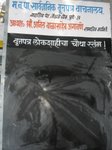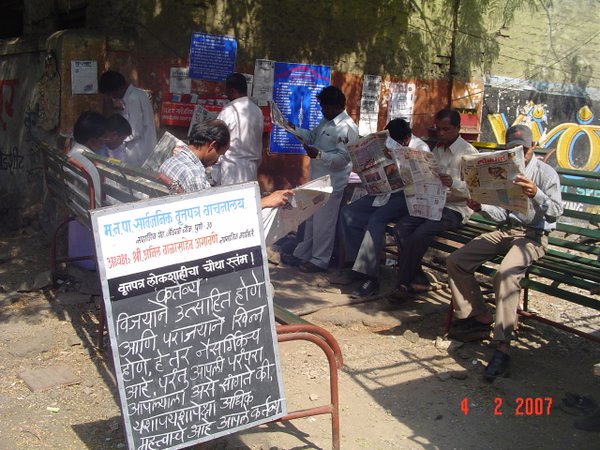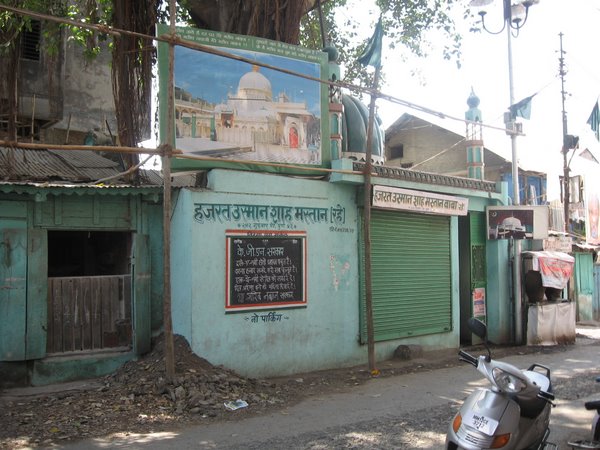Hi all! Am just managing to put in my second posting before my designated week gets over. I’m beginning to think this practice is nice though…gives you a chance to stop and look back on where your work is going. And this is how and where my work is going:
By now I have a fairly concrete idea of what is the pattern of content of the notice boards (vartaphalak) I’ve been covering in different areas. To give a crude categorization, here are the ‘types’ of content that are put up in the vartaphalak:
Pertaining to religion: There are actually three broad categories in this type. The first one concerns overtly technical information about religious practices (in the context of Hindu religion of course). Very pedagogic in nature, these are small tips on how to perform puja, where to place ritual objects, how to make a ritual offering, what is the significance of a particular festival and so on. The language used is extremely formal, some of the words almost alien to everyday language. These boards are homogenous since they are ‘adopted’ by a local organization ‘Sanatan Sanstha’, whose volunteers write these messages on the various vartaphalak. I’m not yet completely sure what the organization is all about, whether it is affiliated to the political Hindu right and so on. More on this in the next posting definitely!
The second type is again related to religious teachings, but which are largely couched in a spiritual-moral discourse. The 3-4 Muslim boards included in this study fall in this category. For instance, some of the messages generally revolve around extolling the virtues of Khwaja Garib Nawaaz or explaining the generosity of a particular pir.
Lastly, there are the overtly Hindu fundamentalist vartaphalaks, which have a specific agenda of consistently spewing forth hatred against Muslims and Christians. The content here is acidic, the rhetoric strongly communal. It is not a surprise that these 3 vartaphalak are to be found in the Sadashiv Peth-Narayan Peth areas, which are almost exclusively Brahmin populated.
The moral discourse: I have given this title to this category for the want of a better term. But I’ll try and explain what exactly it entails. There are 3-4 such vartaphalaks, wherein a ‘Suvichar’ (Thought for the day) is written everyday. There is a strong rhetoric of morality, ‘good’ behaviour, ethics, values like humanism, benevolence, courage that is reflected in these messages. They present an archetype of ‘ideal’ citizen, who is moral, ethical and patriotic in his outlook.
Political commentaries: This is an interesting category. There are 2 vartaphalaks which constantly engage in commenting on the recent political happenings, at the local as well as the national level. Both the boards use an irreverent, satirical style while critiquing the happenings around them.
I will try and give a sample of a few messages of each category the next time.
I have also realized that the frequency of these messages tends to be pretty inconsistent, barring a few. So some boards that regularly used to change their content, have now hardly anything new to say. In such cases, I’ve been confused as to whether to include these in the study or omit them.
By now I have almost close to 300 photographs, since a photoessay is also one of the outcomes of this study. It’s a shame one cannot put up images on the reader-list, otherwise it would have given everyone a greater sense of what I was saying.
That’s all for now. Waiting for some feedback, comments, whatever.
By now I have a fairly concrete idea of what is the pattern of content of the notice boards (vartaphalak) I’ve been covering in different areas. To give a crude categorization, here are the ‘types’ of content that are put up in the vartaphalak:
Pertaining to religion: There are actually three broad categories in this type. The first one concerns overtly technical information about religious practices (in the context of Hindu religion of course). Very pedagogic in nature, these are small tips on how to perform puja, where to place ritual objects, how to make a ritual offering, what is the significance of a particular festival and so on. The language used is extremely formal, some of the words almost alien to everyday language. These boards are homogenous since they are ‘adopted’ by a local organization ‘Sanatan Sanstha’, whose volunteers write these messages on the various vartaphalak. I’m not yet completely sure what the organization is all about, whether it is affiliated to the political Hindu right and so on. More on this in the next posting definitely!
The second type is again related to religious teachings, but which are largely couched in a spiritual-moral discourse. The 3-4 Muslim boards included in this study fall in this category. For instance, some of the messages generally revolve around extolling the virtues of Khwaja Garib Nawaaz or explaining the generosity of a particular pir.
Lastly, there are the overtly Hindu fundamentalist vartaphalaks, which have a specific agenda of consistently spewing forth hatred against Muslims and Christians. The content here is acidic, the rhetoric strongly communal. It is not a surprise that these 3 vartaphalak are to be found in the Sadashiv Peth-Narayan Peth areas, which are almost exclusively Brahmin populated.
The moral discourse: I have given this title to this category for the want of a better term. But I’ll try and explain what exactly it entails. There are 3-4 such vartaphalaks, wherein a ‘Suvichar’ (Thought for the day) is written everyday. There is a strong rhetoric of morality, ‘good’ behaviour, ethics, values like humanism, benevolence, courage that is reflected in these messages. They present an archetype of ‘ideal’ citizen, who is moral, ethical and patriotic in his outlook.
Political commentaries: This is an interesting category. There are 2 vartaphalaks which constantly engage in commenting on the recent political happenings, at the local as well as the national level. Both the boards use an irreverent, satirical style while critiquing the happenings around them.
I will try and give a sample of a few messages of each category the next time.
I have also realized that the frequency of these messages tends to be pretty inconsistent, barring a few. So some boards that regularly used to change their content, have now hardly anything new to say. In such cases, I’ve been confused as to whether to include these in the study or omit them.
By now I have almost close to 300 photographs, since a photoessay is also one of the outcomes of this study. It’s a shame one cannot put up images on the reader-list, otherwise it would have given everyone a greater sense of what I was saying.
That’s all for now. Waiting for some feedback, comments, whatever.





No comments:
Post a Comment